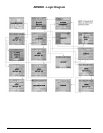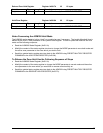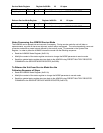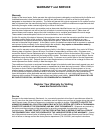
74 Instruction 3015-4275
Notes on Alarms and Alarm Acknowledge
The AGM300 can be operated in two different alarm acknowledge modes, Auto and Manual (set via the
alarm_ack_mode variable in the system data register). For purposes of this discussion, the term “Alarm” refers
to an AGM300 state where the alarm light is on and the appropriate alarm relay is activated. The term “Alarm
condition” refers to the external condition (i.e., refrigerant leak) that initially causes the AGM300 to go into an
alarm. If an alarm occurs it can be handled in one of 3 ways.
1. Non-Latching Mode. This mode is enabled by setting the AUTO_ACK_MODE parameter in the system
register to “1”. In this mode, if an alarm condition occurs an AGM300 alarm will be created. If the alarm
condition is subsequently removed, the AGM300 alarm will automatically be cleared by the AGM300 when
the zone in alarm is sampled “clear”. Note, in this mode of operation, it is possible for an alarm to occur
and be cleared without user or MODBUS master intervention. If this is the case, the only evidence of the
alarm would be contained in the AGM300 alarm log.
2. Latching Mode with Silence. This mode is enabled by setting the AUTO_ACK_MODE in the system
register to “0”. In this mode, if an alarm condition occurs, an AGM300 alarm will be created. In order for
the alarm to be removed the MODBUS master will write a “0” to the ALARM parameter in the ZONE
register. This will cause the alarm to be “silenced” in the AGM300 (i.e., the alarm relays will return to their
normal state and the ALARM lamp will be extinguished). The next time the zone with the alarm condition is
sampled, if the alarm condition still exists, the alarm will be reactivated and the alarm parameter will be
reset to “1” in the AGM300. Otherwise, if the alarm condition has cleared, no further action is required and
normal operation will resume.
3. Latching Mode without Silence. This mode is enabled by setting the AUTO_ACK_MODE in the system
register to “0”. In this mode, if an alarm condition occurs, an AGM300 alarm will be created. The AGM300
MODBUS master will then write a “1” to the ALARM ACK parameter in the zone register. The alarm will
continue to persists (i.e., Relays in alarm state and Alarm light on) until the offending zone is sampled and
no alarm condition is detected. At that point, the ALARM ACK parameter is automatically cleared by the
AGM300, as is the ALARM parameter. NOTE: If the ALARM ACK parameter is set to “1” and the ALARM
CONDITION is upgraded (from leak to spill, or spill to evacuate) the ALARM ACK parameter will
automatically be cleared to “0” by the AGM300.


















